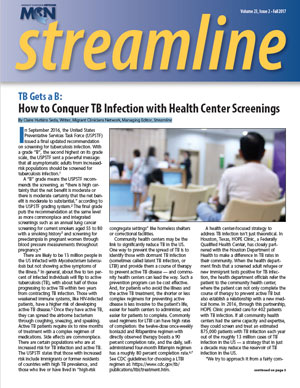Approaches for Establishing a PCMH for Mobile Patients

By Claire Hutkins Seda, Writer, Migrant Clinicians Network, Managing Editor, Streamline
Several years ago, Diana Davis,* an agricultural worker with diabetes, made an appointment at her local health center to refill her prescription for diabetes medication. When a new patient like Davis arrives with health concerns at a health center that has implemented a patient-centered medical home (PCMH) framework, the patient is often brought into the fold with a thoughtful, long-term strategy for her care, through the activation of a care team around the patient and her specific needs. This often means the development of a personalized health plan that is followed up with appointments for support and education from a care manager, a diabetes educator, and others as determined by the primary care provider.
A health center that actively creates a PCMH can improve quality, patient experience, and staff satisfaction, while reducing health care costs.1But the achievement of that famed triple aim breaks down when the patient’s home isn’t stable. In many cases, a care team may have just helped a patient get her diabetes under control when she moves away — and the team never hears from her again. How can we assure that mobile patients can continue to stay on the path to wellness? What does a “mobile home” version of PCMH look like?
Davis had just arrived from Florida, where she had been diagnosed with diabetes after having a heart attack. With her medication in hand, she had traveled north to Pennsylvania for work, where she got a job as the cook for 30 agricultural workers at a farm housing kitchen. Ed Zuroweste, MD, Co-Chief Medical Officer for MCN, was her primary care provider at that first appointment, and immediately saw the predicament: how can we keep her on her personalized plan, if she moves away?
“I explained what diabetes was, because she said that no one had explained that to her before, and gave her education on how to make things better,” Dr. Zuroweste recalled. He spent extra time in the exam room going over how diabetes works, and how behavioral shifts in diet and exercise can greatly improve a person’s health. He then requested a nutritionist to go out to the camp to spend an afternoon teaching her how to cook more diabetes-friendly, healthy foods. The nutritionist ended up going out a second time as well. Dr. Zuroweste recognized that, as a cook, a careful, food-based approach might resonate with the patient — and he was right. By the end of the season, her A1c had dropped from 13 to nine, she had lost some weight, and she understood her medications. Then, she disappeared for nine months. Just like many workers tied to the seasons, she left when the agricultural workers left.
When she finally returned, she had lost more weight and her hemoglobin was down to 7.5. Dr. Zuroweste assumed she must’ve continued with good care at the health center at her new location, but the patient insisted it was not the case. She had gone to another health center, which had not given her any education but just refilled her prescription. “She said, ‘now, I am in charge of my diabetes and I know what I need to do. You’ve taught me that diet, exercise, and taking my medications is what I need to do. I just need you to write the prescription,’” Dr. Zuroweste recalled.
“A lightbulb went off in my head. I was trying to fix patients with diabetes, and manage their diabetes. This patient taught me that what I should be doing is teaching the patients to do all that,” he said. He recognized that sending a nutritionist who spoke the cook’s culinary language may have contributed to the success. He also emphasized that the patients can be empowered because they’re smart, even without a good education: “We don’t give people enough credit. They’re the ones who get the biggest benefit out of all that, so why not put them in charge?”
A PCMH approach to mobile patients includes several approaches, says Dr. Zuroweste. First, the health center can have a coordinated approach to assure the primary care providers in various locations are linked. “If the person always goes from Immokalee to South Carolina and then to Pennsylvania and back to Florida, they go to three health centers, and a case manager at one of the health centers can make sure the medical records transfer. But that is a rarity,” Dr. Zuroweste admitted. Few health centers have the resources available to do such close, long-term tracking of a patient with a chronic concern, but for those that do have the resources, it can be an effective strategy to a mobile patient PCMH.
A second approach is centered on the patient herself. “Make the patient, the individual, the expert on her issue,” Dr. Zuroweste offered. As he discovered with Davis, an empowered patient can be a motivated patient. “Make them, not the primary care provider, the expert in their diabetes, taking the self-management to an extreme level.” In this case, the patient knows about diabetes, understands her medications and dosages, understands the behavioral changes necessary, and recognizes when she will need a foot and eye exam. Dr. Zuroweste also notes that portable medical records can be sent with the patient to make clear to the next health center what steps she has already taken. “Give them the tools, a checklist, all the information they need to become an expert,” Dr. Zuroweste stressed. “It takes a lot of work from the front end, but it has great results on the back end.”
A third approach — perhaps the most effective for the patient and least resource intensive for the health center — is enrolling the patient in Health Network, MCN’s bridge case management system for patients who intend on moving, but whose health needs are ongoing. Health centers utilize its services in many ways: a patient who got a pap smear but will be moving to a new state may be enrolled for a short time to assure she receives the results despite her new location; a student with HIV may be tracked when he leaves for summer break to visit home, and then returns to school; or, it may be used for patients with chronic concerns who remain mobile over many years, like agricultural workers who continually move with the seasons. Patients are enrolled for free by clinicians at the patient’s health center, after which a Health Network Associate follows up with the patient to confirm their enrollment, offer Health Network services, and assure the patient gets the follow-up he needs. The Associate transfers medical records, sets up appointments, and assists with additional services like transportation as needed and as available.
“You can do all three,” reminded Dr. Zuroweste. “If you can create a PCMH for a mobile population then you’ve really got a solid PCMH at your institution, because if you can address those complex issues of mobility, then it’s easy to do for people who are stable.”
* The patient’s name has been changed to protect her identity.
- Science in Brief: The Patient-Centered Medical Home: Current State of Evidence. Centers for Disease Control and Prevention. https://www.cdc.gov/dhdsp/pubs/docs/science_in_brief_pcmh_evidence.pdf. Accessed June 5 2017.
Read this article in the Fall 2017 issue of Streamline here!
Sign up for our eNewsletter to receive bimonthly news from MCN, including announcements of the next Streamline.
